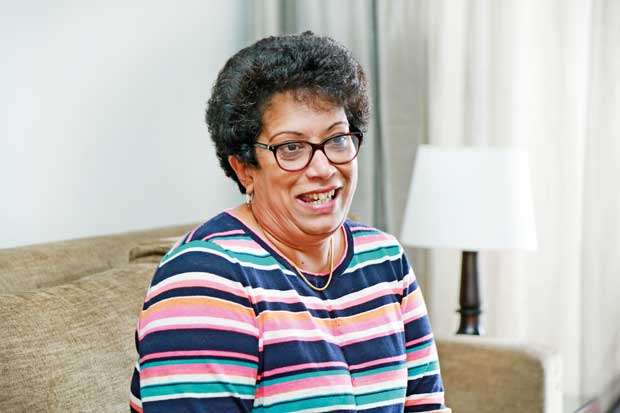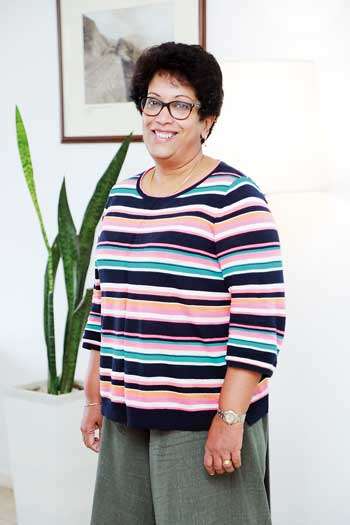14 Sep 2018 - {{hitsCtrl.values.hits}}

I recently read in the news that some of the early warning towers had been vandalised in Mullaitivu. What would have happened to the people who are relying on that particular early warning tower if a disaster was to take place, on that day
Dilanthi Amaratunga is a Professor of Disaster Risk Management at the University of Huddersfield, United Kingdom with 27 years of experience in the
 higher education sector. She is a leading expert in disaster resilience, currently leading the Global Disaster Resilience Centre, a global leader in interdisciplinary research, education and advocacy to improve the resilience of countries and communities. Her work recognises that with the growing population and more extensive and interconnected environments, the world’s exposure to hazards is increasing. In a recent interview done with The , Dailymirror Prof. Amaratunga discussed challenges, opportunities and concerns related to disaster management in Sri Lanka. Excerpts:
higher education sector. She is a leading expert in disaster resilience, currently leading the Global Disaster Resilience Centre, a global leader in interdisciplinary research, education and advocacy to improve the resilience of countries and communities. Her work recognises that with the growing population and more extensive and interconnected environments, the world’s exposure to hazards is increasing. In a recent interview done with The , Dailymirror Prof. Amaratunga discussed challenges, opportunities and concerns related to disaster management in Sri Lanka. Excerpts:
Q Many global disaster risk reduction campaigns emphasise on the need for immediate action in disaster preparation. Why is this need urgent?
The urban population is increasing at a rapid pace. In Sri Lanka the rural population is still higher, but the urban population is increasing. Globally too, urban populations have risen in numbers and this is quite an alarming trend. On the other hand we have mega cities developing. Even in Sri Lanka people are now migrating to cities in search of economic opportunities. This is actually quite a scary situation as a highly populated city is a recipe for disaster.
Putting these facts in perspective, natural hazards don’t actually kill people, but most of the time, buildings do. When natural hazards interact with other elements, then disaster occurs. This is the difference between a hazard and a disaster.
Disasters play a key role in every sector of the economy. Hazards can actually wipe away quite a number of systems which have been in place. Because of the very good early warning systems in place, the number of people affected by disasters is decreasing; which is a very good sign. Having said that, the economic losses caused by disasters are increasing. Saving lives of course is the most important aspect, but these economic losses cannot be ignored either. Disasters are capable of exposing people to poverty and making them experience other difficulties. That is why I believe that the time to take action is now.

Q How important is disaster risk reduction in order to minimise economic losses?
There is no way that we can prevent natural disasters. The only thing we can do is to be prepared in order to face a disaster situation and make sure that losses are minimal. There’s no science there and anyone should be able to understand this. People need to understand that preparedness is the key. They need to be aware of how best to face a disaster and how to act once it takes place.
In Sri Lanka there is quite a number of small businesses operating. How they would cope after a disaster is an issue which has not really been addressed. This is where the private sector’s involvement is vital. I really don’t see any sort of engagement with the small businesses in Sri Lanka. I also don’t see how they can cope with the aftermath of a disaster. Small businesses especially need the continuity of businesses as it is their lifeline.
Q What is your opinion of the mechanisms put in place by the Government in terms of disaster management?
The issue in Sri Lanka is that it doesn’t treat the subject of disaster management as a multi-stakeholder discipline. Even the public is of the opinion that disaster management is the Government’s responsibility. Of course the state has a major role to play, but it should also be able to bring all stakeholders together.
The Government has recognised the importance of Disaster Risk Reduction and I see this as a very positive move. They have set up the Disaster Management Act, which is headed by the President and the National Disaster Council. The President also graced the launch of the Association of Disaster Risk Management Professionals (ADRiMP), which I believe is encouraging. In that sense I think Sri Lanka has recognised the importance of this field. Certainly there’s lot more to do, but there are some countries in the world where even this recognition does not exist.
Q What are the shortcomings you have observed in Sri Lanka?
One of the major issues I have observed is that people are working in absolute silos. The Government, the Disaster Management Centre (DMC), the Meteorological Department they all work as individual entities. We’re currently engaged in a project bringing in the Met and the DMC together. For the first time they have sat around a table to discuss this particular subject. In Sri Lanka I think people are very much used to working in silos. Be it academia or research, there is no space for discussion. That is why they wanted to promote disciplinary approaches through the launch of ADRiMP. I’m not saying that we need to do blue sky research (research without a clear goal) because we need to be adding to the knowledge. But there are certain areas of research that add direct value to the beneficiaries or the rest of the stakeholders.
Similarly, policy makers always brush aside the science and the research. Instead they consult Wikipedia to find out what is happening. Whatever their policies are, they are not based on the actual science or the latest development. That is why I believe, if it functions properly ADRiMP will have a very important role to play, because it will be independent and will be able to facilitate a platform where people can work collaboratively.
Q Can you name some areas which needs improvement?
The Government has been funding and supporting the Disaster Management Ministry as well as finding resources for the DMC. The investment in these areas has been very visible. But whether these resources have been used properly remains to be seen. I think it is caused by a lack of coordination between different stakeholders. It is imperative that the public must be included as a stakeholder. I don’t know what sort of role the public are expected to play in Sri Lanka.
The state, policy makers, researchers, local Government, private sector and the public need to come together. I believe ADRiMP provides this opportunity.
Q How do you view Disaster Risk Reduction in relation to development efforts in Sri Lanka?
In Sri Lanka, with the construction boom, it is very scary to think about whether they have all the ways of incorporating DRR into their processes. That is why mainstreaming disaster elements into every sector of the economy is very important, but I don’t know if there is a mechanism as such in practice. It would be very interesting to find out what mechanisms are involved.
Q In you view, how can disaster awareness and education be mainstreamed?
Education has an integral part to play in disaster management. In the UK, there are elements of disaster management in the curriculum. Japan is a classic example where children are well informed about disasters. But are we in Sri Lanka knowledgeable to that extent? Or are we just getting kids to run behind the grade 5 scholarships?
We need to start this education at the smallest level, in order to raise awareness. Therefore mainstreaming disaster awareness at every level of the society is imperative, which is the only way the general public will take it seriously. Of course when something goes wrong, the people are very good at passing the blame on somebody. What people need to realise is that everybody has a role to play.
Q How prepared do you think we are as a country for a major disaster?
For Sri Lanka, like many other South Asian countries, the eyeopener was the 2004 Indian Ocean Tsunami. Prior to this catastrophic we weren’t actually familiar with mega disasters. Soon afterwards there was a great volume of investment made in the name of Tsunami preparations which happened at a good scale at the time.
However, now the world is beginning to focus on a multi-hazard approach in managing disasters.
None of the countries can invest on systems for individual hazards as it is very expensive. Therefore the concept of multi hazard preparation has been developed. However I’m not aware of the strategies developed in Sri Lanka as far as the multi hazard concept is concerned or whether we are still dealing with individual hazards.
Similarly, policy makers always brush aside the science and the research. Instead they consult Wikipedia to find out what is happening
Even though hazards cannot be prevented, we can always prepare for them and minimise adverse effects by communicating it to the general public. The ordinary person needs to know what to do, where to go and what immediate steps they should be taking. This is a primary responsibility of policy makers.
Q What is your opinion on the country’s preparedness in the event of a Tsunami?
The Tsunami early warning front has been quite good in the past. I was here as an international observer for the International Tsunami drill on September 5. The drill is conducted in order to test the system. Tsunami wise, therefore Sri Lanka has some form of preparation. On other fronts, particularly in disaster continuity, there’s a lot to be desired.
With the construction boom in Sri Lanka, we sincerely hope there will be no earthquakes or any other form of disaster. After the Indian Ocean Tsunami the entire earth has moved by so many centimetres, which is actually a significant change in terms of geology. Since then, there have been several Tsunamis. This is why we cannot disregard the possibility of yet another Tsunami. We need to be prepared especially because of all the changes happening around us such as the extreme changes in temperature and melting of glaciers. All these things are interlinked.

Q Do you think there is room for improvement in terms of technological capacity and expertise in Sri Lanka?
We absolutely can’t be complacent in disaster management. You can never know enough and this attitude is particularly a Sri Lankan problem. We need to be constantly updated with our knowledge.
There needs to be a 100% change of attitude. Why does UNESCO spend millions of money annually training people from all around the world, if it is a futile exercise? I’m one of the professionals of the Indian Ocean Early Warning system training team. If everything is in order there really wouldn’t have been a need to invest billions of dollars in training. This is done because there are changes we need to adapt at any given time. We can never be complacent because we have a very good system in place. The system is only the operational side of it. If the system is not based on the latest findings, then what’s the point of having a system?
I recently read in the news that some of the early warning towers had been vandalised in Mullaitivu. What would have happened to the people who are relying on that particular early warning tower if a disaster was to take place, on that day? Having a system in place is futile if it is not constantly tested. We need to evaluate if the system reflects whatever the latest findings coming in from other directions. Of course, Sri Lanka is still a developing economy and it does not possess the infrastructure nor the capacity like India and Jakarta. But we need to make sure that there is a really good downstream mechanism to pass on the information and to take action on the various levels of warnings.
Q What is Sri Lanka’s position in terms of climate change adaptation?
People should know that climate change will have direct and indirect impacts. Direct impacts are quite visible in the form of droughts, floods and changes in seasons. In the past Sri Lanka had been a very prosperous country and we had a really good balance of the sun and the rain. But we are losing that balance now.
What they can’t see and need to be aware of are the things happening elsewhere in the world which can have an impact on Sri Lanka. This is why the public should not be complacent about things. For instance people cannot pacify themselves into thinking that there won’t be another Tsunami in their lifetime. That is a very
dangerous assumption.
Recently in Indonesia there were two major earthquakes and due to their preparation, they were able to save a great number of lives. If they weren’t prepared I’m sure the number of deaths would have been more. Northern Pakistan for example is full of glaciers. Because of increased temperatures, they have started to melt. Experts have warned that it is a Tsunami in the making because the ocean will not cope. If their predictions are proven true, Sri Lanka is vulnerable to a major impact. Rising sea levels are other areas we really need to focus on. We need to be prepared and vigilant and cannot afford to be complacent about any type of disaster.
Q What are the opportunities and challenges you see for Sri Lanka?
I need to admire the commitment of the leadership irrespective of which party they represent. The country as a whole is completely committed and is a signatory to the Sendai framework.
There is also fairly a decent research base on the subject matter while new courses are introduced at the Colombo and Peradeniya Universities. There’s a lot of building going on in the country and believe that some are very good opportunities.
In terms of challenges, the silo needs to be rid of and public engagement is key. I have observed that the academia is reluctant probably due to a lack of trust. They work in isolation. The practitioners think the researchers don’t share information; therefore the mistrust needs to be cleared. These two groups need to come together which is a very big challenge.
Pics by Damith Wickramasinghe
10 Jan 2025 24 minute ago
10 Jan 2025 1 hours ago
10 Jan 2025 2 hours ago
10 Jan 2025 4 hours ago
10 Jan 2025 4 hours ago